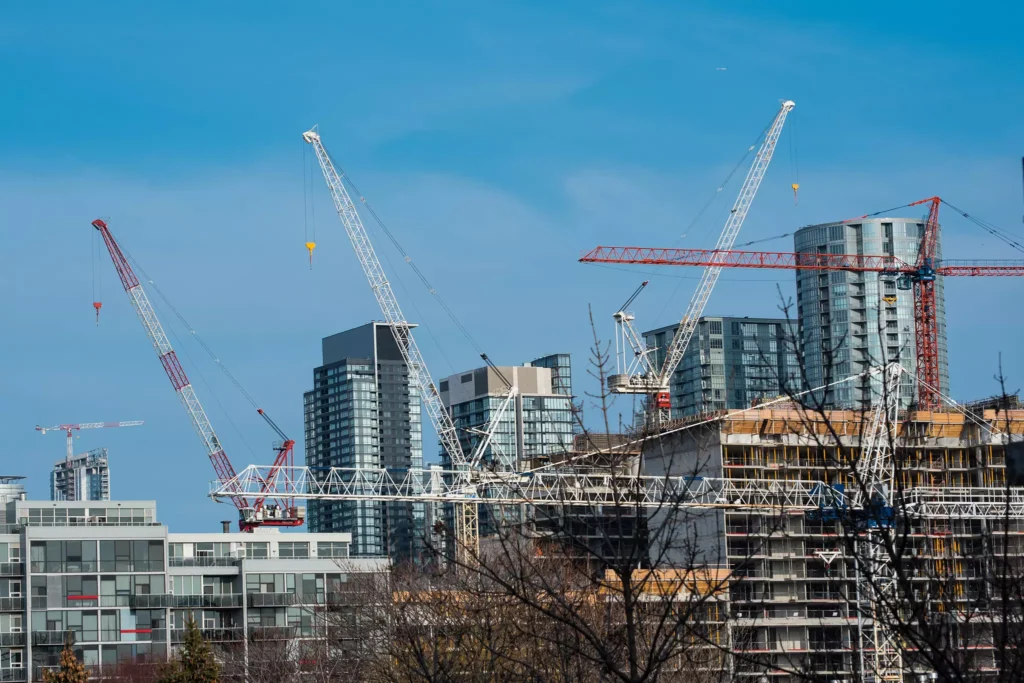Nearly all Canadians will agree that Canada is in the middle of a housing crisis. We are not alone in this, with the US, Australia, New Zealand, and even the UK also experiencing problems with housing affordability.
The conventional wisdom from YIMBYs, our media, and politicians is that this is only a matter of lack of supply. Nevertheless, the federal government has had to admit that the number of temporary immigrant visas has far too high. Now, the Trudeau government is in damage control mode, reducing temporary worker and foreign student visas – while still defending a permanent immigration target of 500,000 a year.
Unlike the US, where housing starts are well below their 2006 peak, Canada had 40-year record high housing starts in 2022. In fact, 8.5% of our GDP is in housing construction. The number of people in construction has rocketed up since 2000, faster than nearly every other type of employment.
Canada actually has a record number of housing units under construction today, but the problem is that the majority are apartment type units, not detached homes. Apartments take far longer to build and require more skilled labour – particularly for buildings over 6-storeys.
What is particularly strange is that the issue of fourplexes, also known as quadriplexes, has become a major political issue.
Fourplexes? People in other countries must think we are nuts. But this is part of a broader neoliberal YIMBY agenda which maintains that upzoning will somehow solve our housing woes – even though it takes years from rezoning to completion, and in Ontario, provincial policy since 2005 has been to promote higher levels of housing. Even before that, the approach of the Ontario Municipal Board (OMB), now called the Ontario Land Tribunal (OLT), meant that local government planning decisions were more often than not overridden at “de novo” hearings where the OLT essentially ignored local government. These hearings are quite unlike a more typical appeal process like judicial review, where there needs to be a clear error or flaw in a government decision to override it.
Pierre Poilievre and others complain that municipal “gatekeepers” are the problem. But in Ontario, local governments are not very effective as “gatekeepers” because local politicians don’t really have the keys to the gates, and there is no lack of land zoned for densification. In the City of Toronto, according to a 2022 development “pipeline” report, there were 200,000 units rezoned and unbuilt, enough for 13 years at the roughly 16,000 annual rate of recent years. There were an addition 400,000 more units in applications, most of which will be approved. This means the City of Toronto should have up to 37-years worth of housing units zoned, before any of the recent upzoning changes such as ending “exclusionary zoning”.
One recent analysis put the total number of pre-construction housing units in the Greater Toronto & Hamilton Area (GTHA) at over 1.2 million units – enough units for nearly 3 million people (assuming 2.5 per household).
Fourplexes and triplexes were already legal for decades in most of Toronto, particularly in the pre-WW2 residential areas – like in the Beaches where I live. Near the Boardwalk, you can see the charming 100-year-old “Price Brothers” fourplexes, or double duplexes, with massive front porches and columns that might remind a passerby of the antebellum US South.
In fact, these types of buildings were built in Toronto in significant numbers from 1950 to 1980, so often that there is a name for them – the “Toronto Special”. They are typically brick and have 3 floors, typically with the front door and stairwell off to one side, with each apartment taking up a full floor, and near identical apartments stacked on top of each other.
People forget that the Beaches neighbourhood, like Rosedale and Parkdale, was full of rooming houses even into the 1970s. The “Toronto Specials” were built in many neighbourhoods as the middle and upper classes fled to the new suburbs. The older neighbourhoods tended to be cheap and property values were low, and immigrants moved in to replace those moving to the ‘burbs.
Few Toronto Specials or multiplexes have been built since 1980, despite being legal in the parts of the city that were best served by transit. This is because they no longer made sense given the combination of rent controls since the mid 1970s, plus gentrification, which meant that housing prices rose and rooming houses were converted back to single family homes.
In older Toronto neighbourhoods like the Beaches, new construction is almost always single-family luxury homes, or sometimes semi detached homes. Also, lots that are wide enough for multiplexes are split, severed into two narrower lots, with two skinny homes replacing an older home deemed worthy of demolishing.
New constructions, like new cars, command higher prices than older used ones. With gentrification, few buyers want to be landlords, save maybe for a basement apartment that can easily be converted back. Demolishing an old home is not going to provide “affordable” housing, even if developers took only a small profit instead of selling for more at whatever the market will bear.
A condominium building of 3 to 5 units is also not common despite being legal. In fact, these are so uncommon that there was significant media coverage of a new condo fourplex in East York in Toronto.
And then there is parking. Most of these old “Toronto Specials” had several parking spots – sometimes in the rear or a lane, sometimes with a built-in garage. Many buyers or renters still want parking, even if they are in an older, more central neighbourhood near transit.
The lack of market demand for new multiplexes is shown by the lack of buyers for existing ones – I checked the MLS listings for Toronto and found a number of multiplexes for sale at reasonable prices that have languished on the market.
For example, there is a nice triplex for sale (shown below) in the Beaches area of Toronto for $2.2 million. It has two 3-bedroom units above ground and a smaller 2-bedroom basement unit, as well as a 3 car garage – all on a 34 ft x 121 ft lot.

This triplex is like buying two $800,000 condos and a $600,000 one in the basement. It is approximately $1000 per square foot including parking. New condos in this part of Toronto sell for more and have a lot of extra costs that new buyers have to pay on top!
It has been on the market for two months. I also found a sixplex near Broadview (with 10 parking spots) for $3.2 million, which is around $825 per square foot – which is well below the price per square foot for new condos. It too has been on the market for two months. A buyer would need a $800,000 down payment, and people with that amount to invest mostly don’t want the bother of dealing with tenants.
The reality is, there are few investors wanting to be a small landlord, or these two listings would have sold long ago. There is no demand.
Upzoning large areas for multiplexes would not result in much new supply. Demolishing an existing home and building a multiplex would cost far more per square foot more than these properties above are listed for (and again, they have attracted no buyers so far).
So, despite all the fuss over the federal government requiring the legalization of fourplexes nearly everywhere, the reality is that likely very few new ones will be built. Few are being built where they are already legal, and demand in new suburbs (farther away from transit and shopping) is certain to be even less.
It is a pointless debate.
Much as Seinfeld was a TV show about nothing, the debate over fourplexes is a debate about nothing. Few units will come of the federal government’s new zoning requirement. Meanwhile, the real source of the housing crisis – high population growth from immigration – is avoided because it involves confronting a sacred cow.
All content on this website is copyrighted, and cannot be republished or reproduced without permission.
Share this article




